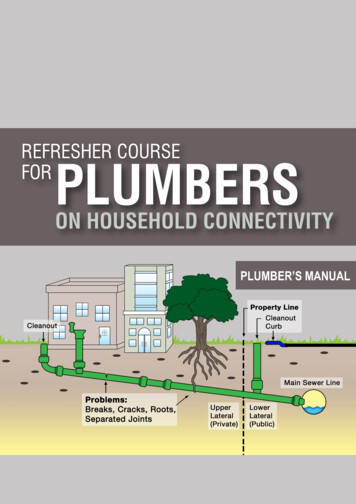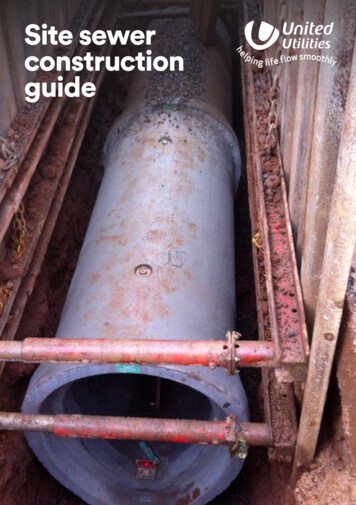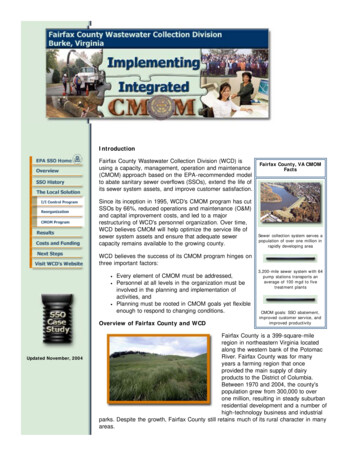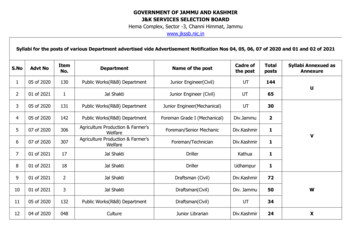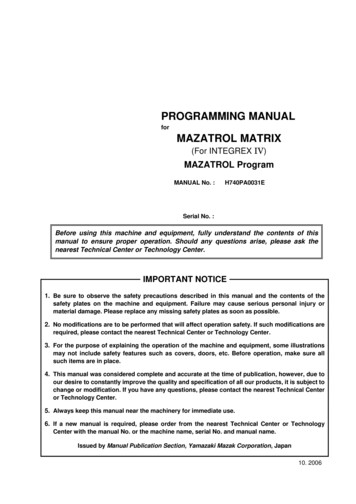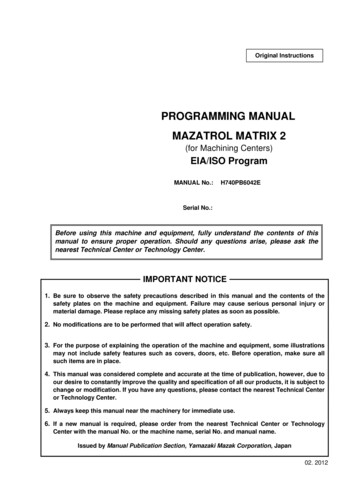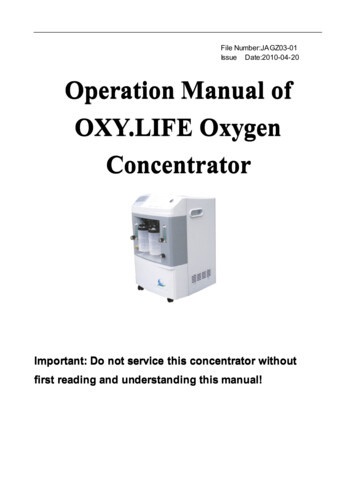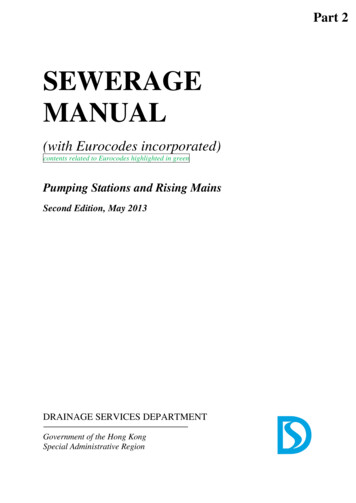
Transcription
Part 2SEWERAGEMANUAL(with Eurocodes incorporated)contents related to Eurocodes highlighted in greenPumping Stations and Rising MainsSecond Edition, May 2013DRAINAGE SERVICES DEPARTMENTGovernment of the Hong KongSpecial Administrative Region
S1.3DESIGN STANDARDS1.3.1 Mechanical and Electrical Systems1.3.2 Sewerage Structures1.4DESIGN FLOW1.5DESIGN MEMORANDUM1.6ENVIRONMENTAL ASPETCS1.7REQUIREMENT OF SUSTAINABILITY1.8HARBOURFRONT ENHANCEMENT REQUIREMENTPUMPS & COMPONENTS2.1TYPES OF PUMPS2.2CENTRIFUGAL PUMPS2.3ARCHIMEDEAN SCREW PUMPS2.4SELECTION OF PUMPS2.5PUMP MOTORSPUMPING SYSTEM3.1INTRODUTION3.2DESIGN PHILOSOPHY3.3OPERATING CHARACTERISTICS AND SYSTEM CURVES3.4NUMBER OF PUMPS
34.5.3.5TWIN OR MULTIPLE RISING MAINS3.6CAVITATION3.7ECONOMICS3.8SURGE ANALYSISDESIGN OF SEWAGE PUMPING STATIONS4.1INTRODUCTION4.1.1 Classification of Sewage Pumping Stations4.1.2 Wet Well/ Dry Well Pumping Stations4.1.3 Submersible Pumping Stations4.1.4 Screw Pumping Stations4.2WET WELL/ DRY PUMPING STATION DESIGN4.2.1 Wet Wells4.2.2 Hydraulics4.2.3 Wet Well Volume and Control Levels4.2.4 Arrangement of Suction Pipe4.2.5 Dry Well4.3SUBMERSIBLE PUMPING STATION DESIGN4.4SCREW PUMPING STATION DESIGN4.4.1 Key Design Parameters4.4.2 Screeding Requirements4.5PUMP CONTROLANCILLARY FACILITIES OF SEWAGE PUMPING STATIONS5.1GENERAL5.2ELECTRICAL SYSTEM SUPPLY5.2.1 General5.2.2 Maximum Power Demand5.2.3 Maximum Instantaneous Load5.2.4 Supply Voltages5.2.5 Power Transformer5.2.6 Security of Power Supply5.2.7 Starting Equipment5.2.8 Statutory Regulations5.2.9 Energy Efficiency and Power Quality
45.2.10 Renewable energy6.5.3MONITORING AND CONTROL5.4SCREEN5.5STANDBY AND SECURE POWER5.6LIGHTNING PROTECTION5.7LIFTING EQUIPMENT5.8PENSTOCKS AND STOPLOGS5.9OTHER FACILITIESLAND REQUIREMENT6.1GENERAL6.2 SCREW PUMPING STATIONS6.3 PUMPING STATIONS WITH CENTRIFUGAL PUMPS7.RISING MAINS DESIGN7.1HYDRAULIC DESIGN7.1.1 Steady State Hydraulics7.1.2 Transient State Hyraulics7.1.3 Surge Suppression Methods7.1.4 Negative Pressure Prevention Methods7.1.5 Methods to Reduce Pressure Rise7.2PIPE MATERIAL7.3DISCHARGE ARRANGEMENTS7.3.1 Function of Discharge Sump7.3.2 Layout of Discharge Sump7.3.3 Size of Discharge Sump7.4PROFILE AND VALVES7.4.1 Air Valves7.4.2 Vented Non-return Valves7.4.3 Wash-out7.4.4 Isolation Valves7.4.5 Access Hatch
57.5THRUST BLOCK7.5.1 Purpose of Thrust Block7.5.2 Design Assumptions7.5.3 Calculation of Thrust at a Pipe Bend7.6CONTROL OF SEPTICITY7.7EXPOSED PIPELINES AND PIPE BRIDGES7.7.1 Leakage Detection7.7.2 Planting in the Vicinity of Sewers7.7.3 Pipeline along Bridge Structures7.8MANHOLES AND CHAMBERS7.9LAYING OF SEWER ALONG SLOPES7.10 SEWERAGE WORKS IN CONJUNCTION WITHROADWORKS8.9.STRUCTURAL DESIGN OF PUMPING STATIONS8.1GENERAL8.2AESTHETICS8.3DESIGN REQUIREMENTS8.3.1 Exposure Conditions8.3.2 Strength of Concrete8.3.3 Maximum Permissible Crack Width8.3.4 Concrete Cover to Reinforcement8.3.5 Specification of Concrete for Retaining Sewage8.3.6 Reinforcement for Thermal Effect8.3.7 Hydration Temperature8.3.8 Seasonal Fluctuation of TemperatureCOMMISSIONING OF PUMPING STATIONS10. ODOUR AND NOISE CONTROL10.1 SOURCE OF ODOUR10.2 ODOUR CONTROL MEASURES10.2.1 Legislation10.2.2 Identification of Principal Odour Sources10.2.3 Control on Formation of Odour10.2.4 Good Housekeeping
610.2.5 Containment of Odour Sources10.2.6 Ventilation10.2.7 Design Modification10.3 ODOUR ABATEMENT METHODS10.3.1 Adsortpion10.3.2 Absorption10.3.3 Biological Methods10.4 NOISE CONTROL10.4.1 Legislation in noise10.4.2 Common Sources of Noise in Sewerage Works11. FLOW MEASUREMENT AND VENTILATION11.1FLOW MEASUREMENT11.1.1 Electromagnetic Flowmeter11.1.2 Open Channel and Partial Pipe Flow Measurement11.1.3 Doppler Transducer Flow Measurement11.1.4 Venturi and Flow Tubes11.2VENTILATION11.2.1 General11.2.2 Ventilation Rates11.2.3 Types of Fans12. OPERATION AND MAINTENANCE ASPECTS12.1RISING MAINS12.1.1 Spare Parts12.1.2 Inspection12.2 SEWAGE PUMPING STATIONS12.2.1 Operation Activities12.2.2 Data Collection12.2.3 Maintenance12.2.4 Contingency PlanREFERENCESTABLESLIST OF TABLESTABLES
7FIGURESLIST OF FIGURESFIGURES
81.1.1INTRODUCTIONSCOPEPart 2 of this Manual offers guidance on the planning, design, construction,operation and maintenance of the sewage pumping stations and rising mains in Hong Kong.For guidance on gravity sewerage system, please refer to Part 1 of this Manual. DSD hasalso promulgated Practice Note No. 1/2011 “Design Checklists on Operation &Maintenance Requirements” which can be reached on DSD’s internet home page :www.dsd.gov.hk. Readers are requested to go through the Practice Note, or its latest version,when designing sewage pumping stations and rising mains to ensure that the final productssatisfy the operation and maintenance requirements of the maintenance authority.1.2ABBREVIATIONSThe following abbreviations are used throughout this Part 2:ADWFArchSDAPCOBDBSBSIBS GRPHATSHDPEHyDICAAverage Dry Weather FlowArchitectural Services DepartmentAir Pollution Control OrdinanceBuildings DepartmentBritish StandardBritish Standards InstitutionEuropean Standards adopted as British StandardsBottom Water LevelCivil Engineering and Development DepartmentDrainage Services DepartmentDry Weather FlowDry Weather Flow InterceptorElectrical & MechanicalEurocodes (i.e. European Standards EN1990 toEN1999)Environmental Monitoring & AuditingElectrical and Mechanical Services DepartmentEuropean StandardEnvironmental Protection DepartmentEnvironmental Impact Assessment OrdinanceFibreglass Reinforced PlasticFire Services DepartmentGeotechnical Engineering Office (formerly knownas Geotechnical Control Office)Glass Reinforced PlasticHarbour Area Treatment SchemeHigh Density PolyethyleneHighways DepartmentInstrumentation, Control and Automation
9ISOMDPENCONPSHP/SSCASCADASMPSMPRSSSSTWSWLTWLUK NAuPVCUPSWCZWPCOWSD1.3International Organisation for StandardisationMedium Density PolyethyleneNoise Control OrdinanceNet Positive Suction HeadPumping StationSewerage Catchment AreaSupervisory Control and Data Acquisition SystemSewerage Master PlanSewerage Master Plan ReviewSewage Strategy StudySewage Treatment WorksSafe Working LoadTop Water LevelUnited Kingdom National Annexes to EurocodesUnplasticized Polyvinyl ChlorideUninterrupted Power SystemWater Control ZonesWater Pollution Control OrdinanceWater Supplies DepartmentDESIGN STANDARDS1.3.1 Mechanical and Electrical SystemsThe following design standards, or their latest versions, are to be adopted, exceptotherwise stated in this Part 2:Design ElementsSwitchboardLightning protectionLifting applianceDesign of pipelines on supports/piersDesign StandardsBS EN 60439-1, 61439-1 & 2BS EN 62305-1 to 4BS 2853 and BS EN 1993 & 13001BS 80101.3.2 Sewerage StructuresIn Hong Kong, sewerage structures are currently designed to BS, either directly as inthe case for water retaining structures to BS 8007, or indirectly as in the case for structuressubject to highway loading to BS 5400 customized by the local guiding document. Inview of the progressive replacement of BS by EC (EN 1990 to EN 1999) and their UK NAthrough the promulgation of BS EN standards since March 2010, Government has plannedto migrate from BS to EC and UK NA in 2015. To cope with the migration, a transitionperiod from 2013 to 2014 is set out during which the designer may opt for using BS or ECand UK NA in conjunction with local guidance/documents as appropriate for structuraldesign of the sewerage structures (e.g. manholes or tunnel sewers in Part 1, or sewagepumping stations in this Part 2, etc.). Starting from 2015, the use of EC and UK NA cumlocal guidance/documents as appropriate will become mandatory. The following designstandards, or their latest versions, are to be adopted, except otherwise stated:
10Design Elements/LoadsDesign StandardsImposed loadsCode of Practice for Dead and ImposedLoads, BDTraffic loadsStructures Design Manual for Highwaysand Railways, HyDWind loadCode of Practice on Wind Effects in HongKongReinforced concrete structuresBS EN 1990 and BS EN 1992 (in general)-Pumping Station-BS EN 1992 (superstructure) and BSEN 1992-3 (substructure)-Tunnel lining-BS EN 1992-3 (liquid retainingproperties) and GEO Manuals,Guidelines and Publications(geotechnical)-Manholes (other than standardmanholes in DSD standarddrawings) and Chambers-BS EN 1992-3Foundation-Deep and shallow foundations-Code of Practice for Foundations, BD(structural design) and GEO Manuals,Guidelines and Publications(geotechnical design)-Reinforced concrete design forraft and pile cap-BS EN 1992Earth retaining structuresGuide to Retaining Wall Design, GEORecommended design parameters for concrete and steel reinforcement are given inTable 3.1.4DESIGN FLOWAn essential element in the design of a pumping system is the consideration of initialflow and subsequent build-up of flow with time. Reference should be made to Chapters 3and 4 of Part 1 of the Manual.Temporary or permanent measures have to be allowed for in the design, construction,commissioning and operation of the pumping system in order to deal with the flow build-up.These measures include variable speed drive for pumps, number of pumps, phasedimplementation, temporary diversion of flow to facilitate commissioning and septicitycontrol.
111.5DESIGN MEMORANDUMIt is essential to summarise key information into a design memorandum for easyretrieval and reference in future. The project engineer should prepare the designmemorandum detailing the following aspects:(a)background of the project;(b)area served, population and flow build up;(c)selected basic scheme plus the possible alternative schemes, together with abrief account of why the basic scheme was selected;(d)design concept and criteria and their justifications (as pumping systemshould be avoided/minimized as far as practicable), which include the systemcharacteristics, design philosophy of the control system, recommendedoperation, list of major equipment, assumptions in the design plusappendices showing key design data and the key elements of work, such asnumber of pumps, heads, capacities; and(e)other requirements of the project (including septicity and odour control,measures to tackle different flow conditions and conditions required forproper commissioning).Other concerned parties, such as the operation and maintenance authorities, shouldalso be consulted when preparing the design memorandum.1.6ENVIRONMENTAL ASPECTSIn the design of the pumping system, the environmental aspects should be given dueconsiderations. Reference should be made to the Environmental Impact AssessmentOrdinance (EIAO), the Water Pollution Control Ordinance (WPCO), the Air PollutionControl Ordinance (APCO), the Noise Control Ordinance (NCO) and the relevant TechnicalMemoranda.1.7REQUIREMENT OF SUSTAINABILITYThe areas of concern on top of economic, social and environmental aspects forsustainability in the design of sewerage are energy requirement and odour control. They areclosely related to the size of the network.It should be noted that the sewage pumping system is not only part of a pipesystem for conveying sewage, it is also a reactor inside which microorganisms are breakingdown the organics and consuming the very limited dissolved oxygen.
12The size of the rising mains, pump sets and pump sumps and the envisageddevelopment phasing are common factors that have an impact on energy requirement forconveying sewage.Septicity should be avoided, as it does not only cause corrosion but also produceodour causing nuisance. It is therefore preferable to prevent the septicity of sewage, byreducing its residence time in the pumping system, mechanical aeration or supply ofchemical oxygen, rather than relying on containing and treating the odour.1.8HARBOURFRONT ENHANCEMENT REQUIREMENTAccording to the General Circular No. 3/2010 with respect to HarbourfrontEnhancement, the Hong Kong SAR Government is committed to protect, preserve andbeautify the harbour. Designers’ special attention is drawn to the fact that once theirproposed facilities or temporary works areas have encroached upon the Harbourfront areasas referred to in the General Circular, they would be subject to the Harbourfront principlesand guidelines so as to meet the public aspirations for a vibrant, green, accessible andsustainable harbourfront.The designers are required to go through the checklist annexed to the circular andshould satisfy themselves that such facilities and temporary works area are essential andwould be able to obtain support from the public before finalization of any part of the designaffecting the Harbourfront areas as referred to in the General Circular. Even so, designersare to engage the public at the earliest possible juncture so as to allow for comments andsuggestions from the stakeholders on their proposals in order to maximize the level ofpublic enjoyment to the concerned areas or facilities.In particular, designers should be vigilant that the occupation of Harbourfront areasby public facilities that are environmentally unpleasant or incompatible with theHarbourfront are not supported in the first place. Where there are no better alternativesafter taking into account cost and other relevant factors, designers should keep the footprintto a minimum as far as possible, and implement necessary mitigation measures to reducethe impact on the Harbourfront. In addition, access to Harbourfront should be reservedwhere practicable for public use and landscaped to compensate for the occupation of theHarbourfront areas by such public facilities.
132.PUMPS AND COMPONENTS2.1 TYPES OF PUMPSPumps may be classified as kinetic energy (rotodynamic) or positive displacementtypes. Kinetic energy types are those that apply energy to the fluid to create velocities thatsubsequently are converted to pressure head. Positive displacement types are those thatapply in the form of direct force, continuous or intermittent energy to the fluid to producethe lift or pressure head.Kinetic Energy(Rotodynamic)CentrifugalMixed FlowPositiveDisplacementAxial FlowRotaryReciprocatingOpenPump TypeSingle or Double Entry VoluteTwo Stage VoluteMultistage Split Casing or Barrel CasingSingle or Multistage Stage WellVoluteBowlWellProgressive CavitySliding Archimedean ScrewPumps in the kinetic (rotodynamic) category can be divided into classifications suchas centrifugal, mixed flow and axial flow. Centrifugal pump is the most common typeappropriate for sewage pumping applications.Positive displacement pumps can be classified as reciprocating, rotary and opentypes. The Archimedean screw pump is the common type in this category suitable forpumping sewage.For sewage pumping, only rotodynamic pump and Archimedean screw pump are usedin DSD. For sludge pumping, ram pump, progressive cavity pump and diaphragm pumpare widely used.2.2 CENTRIFUGAL PUMPSFor rotodynamic pump, different designs are available to cover wide operating range.It is relatively compact. More skill is needed for installation and maintenance. Operatingcharacteristics could be determined at factory. Flow rate is adjustable by changing the
14impeller diameter and speed. It is needed to consider suction head, pump sump, and surge inthe design. Cavitation and pump vibration are major concerns. Material selection isimportant to balance erosion and corrosion. Solid passage, motor efficiency, pumpefficiency, flow control issues and life cycle cost should be considered in selection ofpumps.Centrifugal pump is the most common type of rotodynamic pump used in sewagepumping. A centrifugal pump consists of a set of rotating vanes (impellers), enclosed withina housing or casing and used to impart energy to a fluid through centrifugal force. Impellersof centrifugal pumps can be classified according to major directions of flow in reference toaxis of rotation:(a)Radial-flow impellers;(b)Axial-flow impellers; and(c)Mixed-flow impellers, which combine radial- and axial-flow principles.Radial flow and mixed flow pumps are commonly used for sewage pumping stationwith high head requirements. Vertical installation is normally used since no primingoperation is necessary in starting and small space is required.Axial flow pumps are commonly used for floodwater pumping station with high flowand low head requirements.Apart from the three common types of impellers, screw-centrifugal impeller is alsowidely used for pumping sewage. It has the advantages of high head and large impellerthroughlet.Centrifugal pumps are susceptible to clogging by large solids in raw sewage. It isnecessary to provide a screening device before the sewage entering the pumps. Pumps canbe designed with sphere-passing capacities of 75mm in diameter.2.3ARCHIMEDEAN SCREW PUMPSIn applications where large quantities of sewage and water are raised atcomparatively low head of less than 8.5 metres, Archimedean screw pumps are particularlysuitable. The Archimedean screw pump is a screw rotating in a trough The actual volumelifted depends on the diameter of the screw pump, the speed of rotation, the angle ofinclination and the depth of submergence at the lower end of the pump. The pump unit canbe driven by a variable speed motor for variable flow rates.They can handle large solids in the raw sewage but it is advantageous to installcoarse bar screen with 75 mm to 150 mm spacing at the inlet to prevent large objects suchas timber board from damaging the screw.Archimedean screw pumps are simple in design. Less skill is required formaintenance. Installation is tricky because of its bulkiness. The gap between the trough
15and screw flight affects pump performance. Pump rate can only be determined afterinstallation and has implication on selection of pump motor, coupling, gearbox, V-belt drive.The issues of greasing, safety, flow control, pump & motor efficiency and materials ofconstruction should be considered in the design of Archimedean screw pumps.2.4SELECTION OF PUMPSConsiderations for the selection of pumps include:2.5(a)the characteristics of the pumped fluid;(b)the initial flow and subsequent build-up of flow with time;(c)operating range;(d)the head requirement;(e)the availability of land;(f)the cost; and(g)the operation and maintenance requirements.PUMP MOTORSSewage pumps are normally driven by electric motors.Motors can be installed on ground floor with the pumps mounted on the base of drywell for protection from flooding. Long intermediate shafts are required to drive the pumps.Immersible pumps with direct drive motor installed in dry well are used in mediumto large size sewage pumping stations. No long intermediate shaft is required. The motorsare hermetically sealed to prevent the intrusion of sewage if the dry well is flooded.Submersible pumps with direct drive motor are widely used in small to medium sizesewage pumping stations. The pumps are installed in wet well with submersible motors.The motors are hermetically sealed to prevent the intrusion of sewage. Space of thepumping stations can be reduced since no dry well is required.
163. PUMPING SYSTEM3.1INTRODUCTIONAt the conceptual design stage, it is important to consider whether pumping is reallynecessary. The alternative of a deep gravity sewer should be evaluated carefully. Even whenpumping is required, the length of the rising mains should be kept as short as possible toprovide the required head or overcome the physical constraints.3.2DESIGN PHILOSOPHYThe overall design philosophy of the pumping system has changed from a totalutilitarian approach to a balanced design with due considerations of functional,environmental and a total life cycle cost aspects. For pumping systems in the vicinity ofsensitive receivers such as beaches, residential area and commercial buildings, reliability ofthe system and avoidance of nuisance are of key concerns. Bypass or overflow of rawsewage into sensitive receiving water bodies even in emergency situations should beavoided where possible.To enhance system reliability and avoid the nuisance to the sensitive receivers,particular attention should be paid to the following issues:(a)Design flow and head (please refer to Section 1.3)(b)Standby power supply or temporary storage (please refer to Section 5.5)(c)Standby pumps (please refer to Section 3.4)(d)Overflows and emergency bypass (please refer to Section 4.2.3 (5))(e)Twin or multiple rising mains (please refer to Section 3.5)(f)Odour and noise control (please refer to Chapter 10)The design of a pumping system should include identification of the systemcharacteristics, determination of the number of pumps, control water level, the capacity ofthe pumping system, design philosophy of the pump control system, emergency measuresfor equipment failure, power breakdown, and excessive incoming flow. The energyconsumption should also be considered in the design of a pumping system. The energyinput should be kept at minimum without sacrificing the reliability of the system. Forexample, from energy saving point of view, keeping the water level in the wet-well as highas practicable would help minimize the pumping head.3.3OPERATING CHARACTERISTICS AND SYSTEM CURVESA pumping system may consist of inlet piping, screens, pumps, valves, outlet piping,
17fittings, open channels and/or rising mains. When a particular system is being analyzedfor the purpose of selecting a pump or pumps, the head losses through these variouscomponents must be calculated. The station loss (i.e. the loss on the delivery pipeworkfrom the pump discharge to the common header) should also be considered. The frictionaland minor head losses of these components are approximately proportional to the square ofthe velocity of flow through the system and are called the variable head.It is also necessary to determine the static head required to raise the liquid fromsuction level to a higher discharge level. The pressure at the discharge liquid surface may behigher than that at the suction liquid surface, a condition that requires more pumping head.The latter two heads are fixed system heads, as they do not vary with rate of flow. Fixedsystem heads can be negative, if the discharge level or the pressure above that level is lowerthan suction level or pressure. Fixed system heads are called static heads (Metcalf & Eddy,1981).A system head curve is a plot of total system head, variable plus fixed, for variousflow rates. It may express the system head in metres and the flow rate in cubic metres persecond. A typical system head curve is shown in Figure 1.Procedures to plot a system-head curve are:(a)Define the pumping system and its length;(b)Calculate the fixed system head;(c)Calculate the variable system head losses for several flow rates; and(d)Combine the fixed head and variable heads for several flow rates to obtain acurve of total system head versus flow rate.The flow delivered by a centrifugal pump varies with system head. Pumpmanufacturers provide information on the performance of their pumps in the form ofcharacteristic curves on head versus capacity, commonly known as pump curves. Bysuperimposing the characteristic curve of a centrifugal pump on a system-head curve, theduty point of a pump can be determined.The curves will intersect at the flow rate of the pump, as this is the point at whichthe pump head is equal to the required system head for the same flow.The discharge capacity for multiple pumps will not be simply the sum of thedischarge capacity of individual pumps because the system-head curve for multiple pumpswill be different from that from a single pump (Metcalf & Eddy, 1981).3.4NUMBER OF PUMPSThe number of pumps to be installed depends on the station capacity, the range offlows, the power rating and flow rate of each pump. The maximum discharge rate from apumping station, when all duty pumps and rising mains are in use should be slightly greater
18than or equal to the maximum incoming flow to the station. Pumps should be selectedwith head-capacity characteristics that correspond as closely as possible to the overallstation requirements. Standby capacity is required so that should any of the pumps in thestation be inoperable due to routine maintenance or pump failure, the operation of thestation can still be maintained. For instance, in a station where a single duty pumpprovides the duty output, a second pump of equal capacity is mounted. Where three dutypumps of equal capacity are required to meet the maximum design flow conditions, a fourthpump of similar capacity is provided as standby. Two or more standby pumps should beconsidered for pumping stations of large capacities.For large capacity pumping system with sewage flow ranges varying widely andhighly variable system head, different sizes of pumps should be considered to minimize thepower cost. The assessment of the number of duty pumps and pump capacity are usuallybased on the ultimate flow projection and the projected flow build-up. To cater for slowbuild-up of flow in the early years of operation, phased installation of pumps or using ofsmaller diameter impeller or variable speed drives should be considered. Pony pump forinitial low flow period or other methods should also be considered in the design. If thestaged capacity of the pumping station is still much higher than the sewage flow actuallyencountered in the initial operational period, it may lead to O&M problems, such asinefficient pump operation and high pump start/stop frequency, which in turn result inexcessive hydraulic surge to the pump and piping and fittings and damage to the pump andstarting switchgears.3.5TWIN OR MULTIPLE RISING MAINSThe use of twin or multiple rising mains should be considered on a case by casebasis. The main factors for considerations include the design elements, the risk assessmentand cost benefit analysis.Considerations for the design elements comprise the rate of build up of flow, therange of flow conditions, the range of velocity in the mains, the availability of land for thetwin or multiple mains and associated valve chambers as well as the complications in pumpoperations.A thorough risk assessment should be carried out which should include thelikelihood of main bursting, the consequence of failure, area affected, sensitive receiversaffected such as beaches, the feasibility of temporary diversion or tankering away.A cost benefit analysis should include all tangible factors (such as cost of pipework,land cost, energy cost, etc) and intangible factors (such as nuisance, closure of beaches, etc).Twin or multiple rising mains should be considered in the following circumstances:(a)To accommodate a wide range of flow conditions such that the velocity in the mainscan be kept within acceptable limits. For instance, a pumping system serving anew development may have very low initial flows with a slow build up of flow.(b)To provide continued operation for a major pumping system when one of the mains
19is damaged and where the failure of system would have serious consequence.(c)To minimize adverse environmental impacts to sensitive areas such as beaches.(d)To facilitate future inspection and maintenance of major pumping system while thenormal sewage flow can be maintained.When twin or multiple mains are found to be preferred, it is advisable to use bothmains as duty rather than one as duty and the other as standby from an economical andoperational point of view. Should one of the duty mains be taken out of operation, theremaining one would still be able to deliver a higher quantity of flow at a higher velocity.The occurrence of overflow or bypass can be minimised or even eliminated. Septicity inthe standby mains would also pose an operational and maintenance problem.3.6CAVITATIONCavitation occurs when the pressure in the flow stream approaches the vapourpressure of water. For a centrifugal pump, the lowest pressure occurs at the impeller eye(or inlet). As cavitation can destroy pump parts and is usually accompanied by vibration,cavitation in pumps has to be avoided by providing adequate submergence to suit thelimitations of the pump. Reference should be made to the recommendations of pumpmanufacturers.Net Positive Suction Head (NPSH) is the term used to describe pump cavitationcharacteristics. NPSHav is the total suction head, determined at the suction inlet andreferred to datum, less the absolute vapour pressure of the liquid in m of liquid pumped.NPSHre is the head needed to get stable flow into the pump impeller.NPSHav hbaro hs - hl - hvpwherehbaro pressure head acting on suction water levelhs height from suction water level above the reference level ofimpellerhl total head loss in suction linehvp vapour pressure head of liquid being pumpedTo prevent cavitation, NPSHav must always be greater than NPSHre.3.7ECONOMICSAs the size of the rising mains increases, the velocity and the system head willdecrease, with savings in the cost of pumping. The increase in the capital cost of risingmains will be offset by the power cost of pumping. However, it is also important that thevelocity in the mains should be within suitable range to minimise the deposition of solids.
20Excessive hydraulic head losses are to be avoided. Reference should be made to Chapter 7for recommendations on the velocity in rising mains. Therefore, combinations of differentsizes of rising mains and the system head should be evaluated, taking into account both thecapital cost and the energy cost of pumping. The overall pumping system efficiency shallbe investigated and optimised for the selection of best total life cycle cost solution.3.8SURGE ANALYSISUnsteady flow can occur under a wide range of pump operation scenarios includingpump start, pump cut off, pump breakdown, power failure or malfunctioning of check valve.This can result in considerable changes in pressure. These hydraulic tran
4.2 WET WELL/ DRY PUMPING STATION DESIGN 4.2.1 Wet Wells 4.2.2 Hydraulics 4.2.3 Wet Well Volume and Control Levels 4.2.4 Arrangement of Suction Pipe 4.2.5 Dry Well 4.3 SUBMERSIBLE PUMPING STATION DESIGN 4.4 SCREW PUMPING STATION DESIGN 4.4.1 Key Design Parameters 4.4.2 Sc
